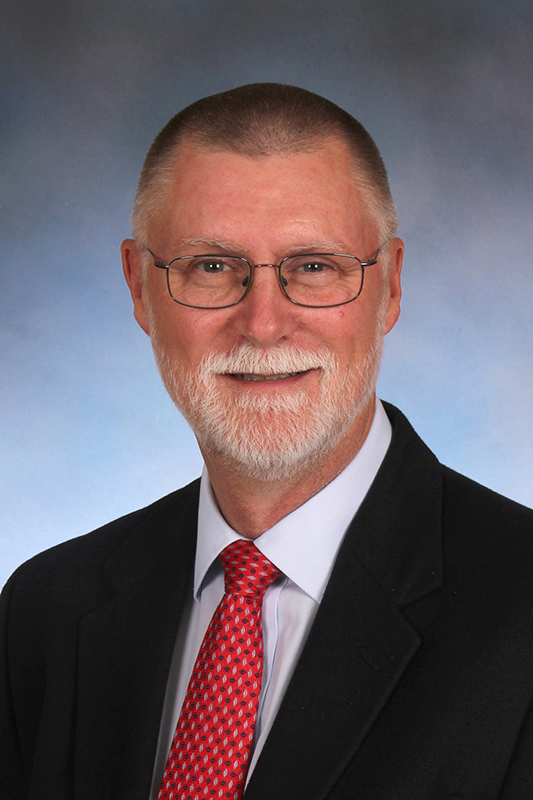
Interim Executive Vice President and Provost Bruce Mcpheron. Credit: Courtesy of OSU
Ohio State’s Board of Trustees convened for an off-cycle session on Tuesday to discuss the future of research at Ohio State — one of the three primary missions of the university.
The meeting featured a presentation by Interim Provost Bruce McPheron and Vice President of Research Caroline Whitacre, who discussed the current state of research faculty at the university, as well as the university’s goal of increasing the number of award-winning research professors, part of the Discovery Themes initiative.
Currently, the university spends $962 million on research, which comes from a variety of sources including government, industry and foundations, Whitacre said. She added that the percentage of research spending that the university itself funds, however, has been increasing — a trend she said has been happening at universities nationally.
In recent years, the university has allocated approximately $350 million to investments related to research, which can ultimately bring in more research funding from government agencies and the private sector. A concern raised by board chairman Jeffrey Wadsworth was how the investment ultimately fared.
McPheron said that while the planning of the Discovery Themes initiative began five years ago, the university only began to spend money on growing the number of highly talented research faculty approximately 10 months ago.
He added that since the university is still in the process of recruiting and developing new faculty members, in the future the university should see more results. So far, the university has hired 35 new faculty members and authorized the hiring of more than 100 researchers. Additionally, there is a gap between when the new faculty arrive and when they begin to generate revenue.
One of the major goals of the initiative was to grow the number of American Association of University recognized awards given to faculty. OSU has approximately 1,100 awards given to its faculty, putting it slightly below the median amongst its peer group, according to Whitacre.
More specifically, recruiting academy-level faculty, or those who are widely considered at the top of their respective fields, has been a major goal of the university. OSU has a total of 31 faculty members who are currently members of one of the three major academies—engineering, medicine and sciences.
Within the peer group, this places OSU above Penn State and Minnesota but below Illinois, Wisconsin and Michigan. Wadsworth said it is also important to be aware that some universities, such as Harvard and University of California, Berkeley, have more than 100 academy members among their faculty.
“The question that came up is, ‘Do we have enough of these people?’ And of course that answer is no,” Whitacre said.
Whitacre said the number of award-winning faculty members is directly correlated to outside research money that is then given to the institution. Additionally, faculty recognition is one of the considerations in the U.S. News and World Report rankings.
“If no one has heard of your faculty, it is an uphill climb to get them to recognize your institution as a great institution,” McPheron said.
Whitacre said the university is using a two-fold strategy to gain new talent — both acquiring talent from other schools as well as developing younger talent already at the university. She said the strategy is to put rising stars up for lesser awards so that later on they might be more qualified for larger recognition.
McPheron added that a normal faculty search is not enough when trying to obtain high-level talent. Often, these faculty look to go to schools with top-level facilities where they know other faculty.
“You want this person who comes in not only to be the only piece in this game, but to be the aggregator that lets other folks up their opportunities,” McPheron said.
Trustee Janet Reid asked if it would be possible for the university to try and get multiple “geniuses” who already work together across disciplines in order to grow the talent at the university.
“We have been in conversations where we talked about poaching entire units from other universities,” McPheron responded. “We have not yet identified one to do the dance with to try.”
One metric that is used to measure success of research efforts is rankings, Whitacre said. Currently OSU ranks 16th among public universities in the U.S. News and World Report rankings, which include research and faculty reputation as a factor in the assessment. McPheron said rankings are not the most important thing when it comes to recruiting faculty, adding that faculty colleagues, facilities and vision for the faculty member’s program are also important.
“Excellence — this is all about having the best faculty in the world,” he said. “It is about becoming a destination for the best intellects in the world. So we build an affordable education and have access to the excellence that is defined by these faculty scholars. And the fact that these areas of investment are defined by problem solving in society, I think is the very definition of the engaged university.”


